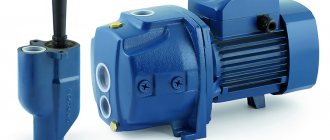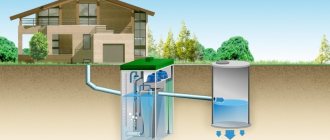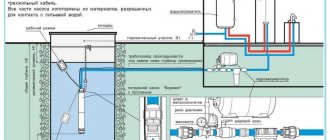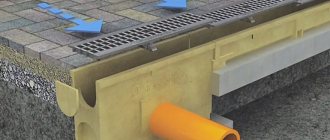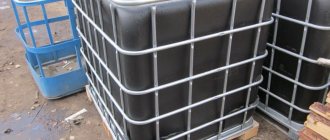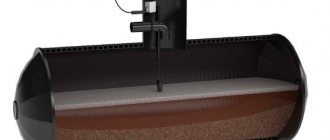A country property is not considered perfect enough for comfortable living if it is not equipped with a system for draining and recycling water used for household needs.
By and large, this is a simple container for sewage in a private house, equipped with a whole set of devices for cleaning wastewater.
The ancestor of such structures is a simple cesspool, the construction of which is prohibited on sites, but they can still be found in operation.
What are the advantages of storage capacity?
- The most economical solution for external sewerage in construction.
- Energy independence: wastewater moves by gravity.
- A very simple design, which determines the durability of such a structure.
- The storage tank can be used for both permanent and temporary or seasonal residence.
- Using a storage tank, you can dispose of almost any waste from the inhabitants of the house, including the remains of vegetables, fruits, spoiled food, pet hair, etc.
- Wastewater in a sealed container does not come into contact with the ground in any way, and therefore is guaranteed not to harm the environment.
What is a sewer container?
If there is no full-fledged sewerage system, you can use an autonomous one, it can be presented in the form:
- Cesspool.
- Storage capacity.
- Mechanical septic tank
- Septic tank with biological filters.
A cesspool, the walls of which are lined with brick or concrete rings, and the bottom remains open. In this case, the liquid passes into the ground, and the pit needs to be cleaned no more than once every few years. Advantages: inexpensive, used as a temporary option. Disadvantages: constant unpleasant odor, inadequate disposal of fecal water.
A storage tank for sewerage is a sealed tank that accumulates waste , which, when filled, is emptied using the services of a utility service. The material can be metal, plastic, fiberglass. The shape and volume can be anything from 3 to 100 cubic meters. m and more; The containers can be connected to each other to increase the total volume for sewage.
The advantage, of course, is:
- the cheapness and simplicity of this method of sewer system, the container itself is buried in the ground, connecting it to a pipe through which all sewage from the house is drained;
- This method of sewerage provides biochemical protection of the site at a high level.
The disadvantage is the regular cleaning of the container using special equipment.
A mechanical septic tank is a closed system that provides a level of purification at which water can be absorbed by the ground without the risk of contamination of the site. It can be made of concrete, metal, plastic.
The advantage of septic tanks is:
- high level of cleaning;
- low price;
- Possibility of underground installation.
However, the disadvantage is:
- limited volume of processed waste liquids;
- annual maintenance requirement;
A septic tank with biological filters that purifies the outlet water up to 98%. These septic tanks are expensive, but the most effective, they can be located near buildings, do not require maintenance and operate for a long period.
What are the disadvantages of storage tanks?
- Only the initial costs of installing the tank will be small. You must be prepared for the constant costs of disposing of sewage using a sewage disposal machine. The cost of calling such a car in the Moscow region ranges from 1500-2000 rubles. depending on the area.
- Storage tanks made of plastic must be anchored to a reinforced concrete slab in an area with a high groundwater level (GWL).
Briefly about installing containers
It is quite simple to install storage tanks for sewerage in a country house, but it is necessary to carry out all the steps correctly, since failure to comply with certain conditions can lead to premature failure of the entire structure or the need to reinstall the tank.
Pit for a septic tank
Sanitary standards require that the container be located no closer than 5 meters from the house. The depth of the pit should be 20 cm greater than the height of the septic tank itself (up to the lid), the width should be 30 cm greater. This is necessary for carrying out certain preparatory work.
The bottom must be covered with a cushion of sand and crushed stone 15 cm thick. Next, the base must be concreted, having previously installed anchors or loops to secure the plastic barrel under the sewer. After complete hardening, you can move on to the next step.
Read about how you can make a brick septic tank with your own hands on our website. The work will take time, but you can save money, since the cost of materials is low.
What is a sewer pipe and whether it is needed at all, you will find out by reading this article.
Tips for organizing a drain in a bathhouse are here https://okanalizacii.ru/sistemy/drugoe/sliv-vody-v-bane-svoimi-rukami.html
Installation of the barrel
Installing a plastic sump for sewage in a pit
The first step is to partially fill the sewer tank with water, simply lower it into the hole, and then secure it to the base using cables and bandages. Next, it is necessary to insulate the container. Of course, usually the septic tank is located below the freezing layer of the ground, and the space inside is heated by wastewater and gas emission processes. However, if the temperature drops significantly, the vital activity of bacteria will drop significantly. The container is insulated using polyurethane foam, polystyrene foam or expanded clay.
Next, it is recommended to line the walls with bricks to prevent deformation of the container and damage to the insulating material, after which it is necessary to pour a certain amount of water into the container and complete the final filling.
You can additionally fill a plastic container under the sewer with concrete to increase resistance to “floating” due to groundwater.
How often will the contents of the container need to be pumped out?
This depends on its volume, living conditions in the house and, accordingly, water consumption. SP 30.13330.2012 “Internal water supply and sewerage of buildings” specifies the standard for water consumption - about 200 liters per day per person. It is easy to calculate that a family of three permanently living in the house will drain about 4.2 m³ of wastewater per week into the sewer. Moreover, the volume of the tank of sewage disposal machines is, as a rule, 4-5 m³. Thus, if a family of three people permanently lives in a house and actively consumes water, it is advisable to provide a storage tank with a volume of at least 8 m³ (as an option, combine several tanks into one network). But even in this case, sewage will have to be pumped out quite often, and this will be expensive. If the container overfills, it will be impossible to use the sewer.
In addition, such a “volumetric” factory-made container costs the same or even more than an aeration unit of a smaller volume, but designed for the same number of people living in the house.
It is important to consider the location of the storage tank. It is necessary to provide the ability to extend the intake hose from the sewage disposal machine to the tank. The standard length of such a hose is 10-15 m, but with the help of couplings it can be extended to 40 m or more. However, the cost of pumping with an extended hose will be higher.
Types of containers for sewerage
Sewage containers vary:
- sizes;
- volume;
- manufacturing material (metal, glass, plastic).
Requirements for containers:
- weather resistance;
- waterproofing;
- chemical inertness;
- capacity;
- resistance to mechanical stress.
It should be noted that plastic containers most fully meet these requirements; they are strong, durable, airtight, and easy to use. Germes-Plast-OC containers are made of plastic with a volume from 3 to 100 cubic meters. m and the cost for a 2-meter dive from the surface of the earth is 60,300 − 1,553,500 rubles. respectively.
Glass storage tanks have a number of advantages:
- no corrosion;
- service life - 50 years;
- low specific gravity;
- performance at low temperatures;
- chemical resistance;
- a float can be built into them to notify the filling level of the tank;
- Possibility of manufacturing according to customer's size;
- products have a quality certificate.
Storage tanks can be combined to increase the total volume of waste liquids.
The cost of fiberglass storage tanks from
Ekostroy for sewerage ranges from 66,400 to 181,000 rubles.
for products with a volume of 5−15 cubic meters. m. respectively. However, upon individual order, the company produces tanks up to 100 cubic meters. m. ZhilKomSnab company produces ribbed septic tanks, due to which the walls prevent compression by soil.
Their cost depends on the volume and ranges from 18,900−44,000 rubles. for 1100−5000 liters, respectively.
Material for making the storage tank
The most popular are structures made from reinforced concrete (well) rings and finished products from one or another plastic - low-density polyethylene, fiberglass, polypropylene. Note that among plastic containers, polyethylene ones are the most affordable. But they have less rigidity compared to polypropylene or fiberglass. Therefore, experts recommend purchasing polyethylene containers with a streamlined shape and thick walls (at least 10 mm) with stiffening ribs. Such products better resist pushing and deformation under groundwater pressure and frost heaving of clay soils. As already mentioned, if installation work is carried out in an area with a high groundwater level, then the plastic container must be anchored to the reinforced concrete slab with nylon or steel cables. Otherwise, during pumping out sewage, an empty container may be squeezed to the surface due to the action of Archimedes’ law.
The disadvantage of storage tanks is often called the unpleasant odor emanating from them. This is only true if such structures are constructed incorrectly. The problem with storage tanks is not only the smell as such, but also the fact that they produce gases that are explosive and poisonous to humans, which must be removed. In this connection, it is recommended to provide ventilation to the sewerage system. The inflow is carried out through a riser built into the storage tank. Exhaust - through a vent pipe leading through the roof, preferably in the area of the ridge (as an option - leading to the roof along the outer wall of the building). With constant ventilation, there will be no unpleasant odor in the storage tank area.
An equally important function of sewer system ventilation is the creation of air rarefaction when toilets are flushed. This prevents water seals from breaking: if the seals break, unpleasant odors will enter the house. The diameter of the riser and waste pipe must be equal to the diameter of the pipes of the main sewer main, that is, 110 mm, if pipes of this diameter are used in the main. The height of the riser above ground level should be such that its head is above the snow cover in winter. That is, approximately 70 cm for central Russia.
Biological products can be added to storage containers, which accelerate the decomposition of sewage and thereby reduce its volume, and also prevent the appearance of unpleasant odors in the sewer. If you decide that a storage tank is not suitable for your family’s living conditions, then you should choose a septic tank made of concrete rings, a plastic septic tank or an aeration unit, which we will discuss in the following articles.
Subscribe to our Telegram channel Exclusive posts every week
Kinds
A storage tank is a well designed for settling and accumulating waste liquids from the sewer system. The main purpose of this reservoir is not just to accumulate wastewater, but to protect the environment from pollution by it.
The classification is made according to the materials from which the well is made and the container. Storage tanks for organizing sewage systems are made of plastic, concrete and metal. Plastic ones are the most convenient to use and easiest to install. They are light, durable, and not damaged by water, but they do have some disadvantages.
Photo: plastic storage
In particular, plastic can be deformed under the influence of earth pressure. To avoid this, they are installed either in a pre-prepared pit with fixed walls, or placed in a metal casing (mesh of reinforcement).
There are such reservoirs:
- Made from PVC. The most common and accessible. On average, they have a wall thickness of up to 4 centimeters, are light, durable, and flexible;
- Fiberglass. Reinforced with fiberglass, they withstand exposure to water and temperature changes, but are destroyed by direct sunlight.
The concrete well is a standard drainage pit. It is very rarely drained for further use. Mostly such storage devices are located underground. They are:
- Open. No bottom. In this case, some of the liquid simply goes into the soil;
- Closed. They have a bottom and require periodic pumping of wastewater.
Ideal for organizing the work of a storm or drainage system, they are very easy to equip with your own hands. There are two installation options: buy a ready-made concrete container or dig a pit, make formwork in it and fill the container over it. They can be made from reinforced concrete rings and square shapes. One of the main disadvantages of concrete storage tanks is their limited service life - they begin to deteriorate after only 10 years of use (for comparison, plastic lasts up to 50).
Concrete storage model
Metal tanks must be additionally protected from corrosion with special paints or enamels. They are considered more convenient than concrete ones, but less practical than plastic ones. In particular, they cannot be installed without additional help.
Photo: metal storage
Also, containers can be of different types of arrangement. They can be installed vertically or horizontally. A vertical wastewater container is used in narrow-shaped areas where it is not possible to prepare a large pit for a storage tank. Horizontal ones are standard and are used on any possible types of plots.
Rules for choosing plastic barrels
So, having decided to use a plastic tank for waste storage, first of all you need to go to a specialized store and buy such a unit. But how to choose the best option? What specific selection criteria are there? Let's define it.
- First of all, you need to decide on the capacity (volume) of the tank, which is extremely important. Since it stores waste, keep in mind that you will sometimes need to pump out the contents as the container fills. If you do not use a shower and use water sparingly (this happens quite often in a dacha), then on average there will be 10-20 liters of waste per resident. If we take into account the use of a shower (which is simply necessary for residential buildings), the norm is a consumption of approximately 200 liters per resident. On average, this number can range from 100 to 150 liters. Taking all this into account, count the number of people in your household and find out the required quantity of the product. A special formula will be discussed below, thanks to which you can calculate the optimal amount.
- When purchasing, special attention should be paid to the neck. The tank must be equipped with a high hatch. For what, you ask? It is required so that the tank can be covered in the ground with a cement slab. Then it will be securely fastened and protected from external factors and excess pressure. Moreover, the plastic tank is quite light, so under the influence of groundwater it may be squeezed out of the ground. This is why the high neck and installed cement slab are serious. And a layer of soil is poured on top of the slab. Moreover, choose products with a wide neck, since then it will be much more ergonomic to work with it when you use different fecal pumps.
- It is worth paying attention to the hatch cover, which should be quite massive and have a screw thread in order to close well. This is extremely important, since anyone can step on it, so if the lid is massive and reliable, it will not break. And so that you can easily unscrew the lid itself, it must have a handle or technological protrusions. As long as the lid closes tightly and well, you will not smell any extraneous “odors” of sewage.
- Give preference to models that have personal stiffening ribs, which makes the entire structure more reliable and gains better strength. Why is this fundamentally important? As you understand, any flat object, such as a sheet of metal, plastic or a board of wood, is easier to break or bend across the plane than along it. Since we are talking about a tank that has a large number, the stiffening ribs, which should go along the probable bend, make the entire structure harder and give it great resistance to external factors. This model will serve you much longer.
- The shape of the plastic tank, ergonomic maintenance and the ability to modernize the design are some other important nuances. Some designs have the opportunity to develop the system in the future and treat wastewater directly on site, producing purified water or sludge. This, of course, is not the main thing that such a design must have, but still, if it can be improved in the future, then this is nice.
Taking into account all the advice, you have the opportunity to purchase a container that fully satisfies your needs and that would serve for a long time and reliably. Now, when everything is ready, you can begin installation work, which you can do yourself.
Why do you need a storage tank?
The need to install a storage tank arises in the following situations:
- Low flow rate of a well or borehole. In this case, the submersible or surface pump, due to its low power and intensive water consumption, does not have time to fill the water supply system and the hydraulic accumulator, which is a mandatory element of automation devices, with water. It is worth noting that the use of a more powerful pump or pumping station in low-flow sources will lead to rapid suction of water, a drop in the dynamic level and, as a result, further operation of water suction devices in idle mode.
- Interruptions in water supply. In some country villages or dachas there is a centralized water supply. However, due to the insufficient power of the autonomous system, water is supplied hourly with long breaks. Or during the day, when everyone uses water resources for watering their gardens and household needs, the pressure in the system drops to almost zero. In this case, the only option for permanent water supply is a water supply system for a private house with a storage tank.
- In city apartments, when the water pressure in the main is low, a booster pump is used. However, its operation while sucking water from a common riser can lead to a lack of water supply in other apartments located above. To get out of this situation, use a storage container that is suspended from the ceiling.
- If there is no source of water intake or, for example, it dries out during a drought, an autonomous water supply for a private house can be provided with imported water from cars. In this case, the use of a reserve storage tank is effective for storing water resources.
Rice. 2 Metal water tanks
Rules for operating a storage septic tank
The minimum service life of a storage unit is about 50 years. Operating conditions do not matter; they can be used in both northern and southern climatic zones of the country.
Critical temperatures do not affect the strength characteristics of septic tanks ; the main thing is to prevent the water inside the storage tank from freezing.
The storage tank does not require maintenance - the main thing is to pump out contaminated water from the tank in a timely manner.
Installation of a plastic tank
One of the serious advantages of plastic products is ease of installation. In addition, if you do not have proper experience in construction and plumbing, you can do everything yourself. All you need is the right tools, following the instructions, some help from a friend or relative and, in fact, desire! Let's divide all the work into a couple of stages to make it more ergonomic and understandable for you:
- First of all, in the place you have chosen, you need to dig a pit or a hole for the tank. To do this, you need to decide on its dimensions, which directly depend on the unit itself. The pit must be equal to the dimensions of the product, plus it is necessary to make a small gap on each side of 50 cm in order to securely fix it in the future.
- So, having determined the required dimensions, for ease of work it is possible to apply them to the soil itself, in other words, make markings. Under such conditions, you will need a tape measure, a hammer, a rope and pegs (you can take pieces of reinforcement). Having marked the future location, you can start digging a pit.
- All work must be done with a shovel and a crowbar, if necessary. It will be easy for you to dig a hole horizontally on your own, but as you go deeper, the work will become more and more difficult. Based on this, we recommend using the help of a “good” friend or relative who will help you. One of you will dig, filling the buckets with soil, and the other will remove them and empty the soil. It is possible to change periodically in order to maintain strength.
- Remember to control all work with a plumb line and level so that there are no strong differences. It is possible that the pit will be uneven and the tank simply will not fit in that direction. In order to protect yourself from unnecessary work on installing and removing the unit, initially control the digging process. At a time when you do not want to dig a pit yourself, and the location and your means allow the use of special equipment, such as an excavator, the easiest way is to hire one to speed up process and save effort.
- After digging a hole, you need to compact the bottom. Compact it and make it more or less even. To prevent the barrel from moving when filling, it is necessary to make a sand cushion at the bottom, which will serve as the base. First, pour a 10 cm layer of sand onto the bottom and compact it. After this, fill the top with a 5 cm layer of gravel. Advice: if you live in an area where the soil is loose and clayey, and groundwater is close to the surface, it is advisable to make a solid concrete base under the tank or install a 20 cm slab. Then the unit will stand securely in its place, without falling or tilting. You have the opportunity to mix the concrete yourself or order it. So that it does not crumble and is stronger, make a frame from reinforcement.
- Now all that remains is to place the container in the prepared place. If the product is large, this work requires the help of friends. In extreme cases, in the presence of huge tanks, they resort to the help of special equipment. It must be taken into account that the plastic container must be placed strictly horizontally, and the inlet pipe must be located closer to the sewer pipe. For reliability, the tank can be secured to the base with cables.
- When everything is done, you need to bring and connect the sewer pipeline to the pipe using a double-sided coupling. In order to provide a slope, it may be necessary to dig a trench where the pipe passes to the branch pipe.
- For reliability, all joints should be checked for leaks in advance, so that you do not have to get to the pipe entry point again. In order to check for leaks, it is necessary to supply a huge amount of water under pressure into the system.
- Now the tank is going to be filled up. Moreover, more than half of the volume should be sand. Sprinkle sand evenly on all sides. In order to compensate for the difference in pressure, you should fill the container with water as the sand is poured. Then the structure will not deform and will not be compressed. Later, all the liquid can be pumped out.
- Another space can be filled with soil that was left during digging. There should only be a hatch left on the surface that needs to be closed well. And on that soil it is then possible to plant a lawn to decorate the area. Advice that the presence of a plastic container for sewage will not affect the non-specialized picture of your estate.
At this point, all work is completed, and your tank is ready for use. If you choose everything correctly and install the container as directed, it will help you for many years, making your stay in your home comfortable and enjoyable.
And so that you can know when it’s time to clean the container, you can use a signal float. The set of some products includes such an element, but if you don’t have it, it doesn’t matter. It is possible to do it yourself. To bring your idea to life, take a steel rod, a catchy foam ball, an aquarium suction cup and liquid nails glue. So, first apply the marking scale to the rod. It’s better if it’s luminescent paint. Place a suction cup on the end of the steel rod, which must be glued to the bottom. This way the rod will be securely fixed and will not damage the bottom. Well, in the end you need to place a catchy ball on the rod, which will move freely along your made scale. Place the float so that when you open the lid, you can immediately notice where your ball is. It will show the amount of content.
As you can see, equipping a container for collecting sewage waste is not so easy. All work can be easily done on your own without the help of specialists, who, by the way, would charge you decent money for this service. It is advisable to use a plastic tank; the material has many advantages, and this design will serve you for a long time. This is, perhaps, an intermediate solution between a septic tank and a cesspool, and it is justified from an environmental point of view.
If you liked the article, write to us about it! We will still be with great pleasure in helping you solve various troubles and issues.
Types of waste storage containers
If we talk about the types of such tanks, then there are two of them:
- Septic tank.
- Storage capacity.
tank
A septic tank is not just a tank in which sewage is collected and stored, it is where partial filtration occurs. When wastewater enters the septic tank, it passes through a pipe into the first treatment chamber, where it breaks down into various individual fractions. Large solid particles settle at the bottom, and small elements with water move to another chamber, where they are “attacked” by bacteria. Fermentation processes occur in these chambers, resulting in the release of methane. In the third compartment, this water is partially filtered and enters the ground. That is why in some areas it is prohibited to install septic tanks.
Storage containers are simply completely sealed and resemble a large tank or barrel for storing something, and in this case, waste seepage from the sewer into the ground is excluded. It turns out that such containers can be used in any area. The distinctive features of such tanks include their shape and size. They are made in both vertical and horizontal shapes, and also have a rectangular or cylindrical design. If we talk about their capacity, then the finished products can contain a fairly large volume - from 1 to 150 m3 of liquid. These structures are equipped with two holes:
- the first hole is the entrance to which the sewer pipeline is connected;
- the second hole is an inspection hole for cleaning the tank when it is full.
Storage capacity
Most often, such a product is installed below ground level, having previously dug a special pit where the unit is placed. Thanks to this, you can preserve the overall appearance of the site and precious space that can be used for other purposes.
It is worth noting that before purchasing a tank, you need to decide what material to buy the product from. After all, a lot depends on this. To help you with this, let's look at what these materials are and what the advantages of each of them are.
Choosing a location for the container
When choosing a location for installing a container, first of all, provide free access for a sewer truck. Since the filled container will certainly need to be pumped out. It is better to install it below the level of the house on the back side and not far from the foundation. The distance should be no more than five meters. If it is not possible to place the container at such a distance, then an additional inspection well will need to be installed on the sewer between the container and the house. Install a container fill alarm sensor in your home to ensure timely pumping.

